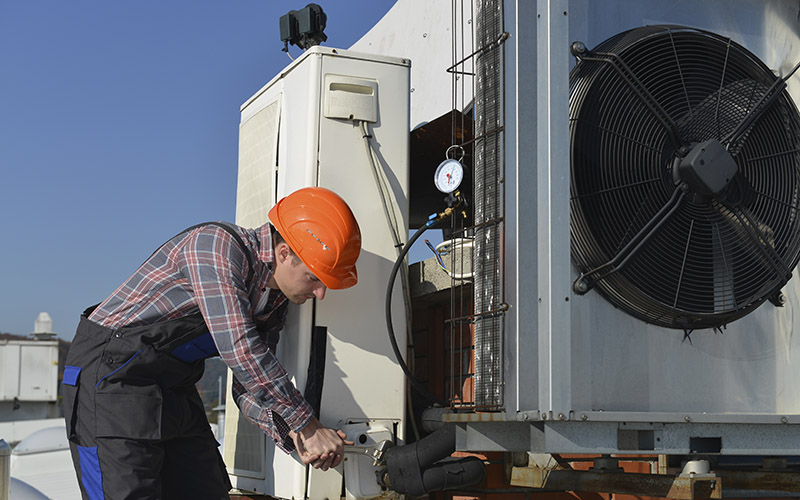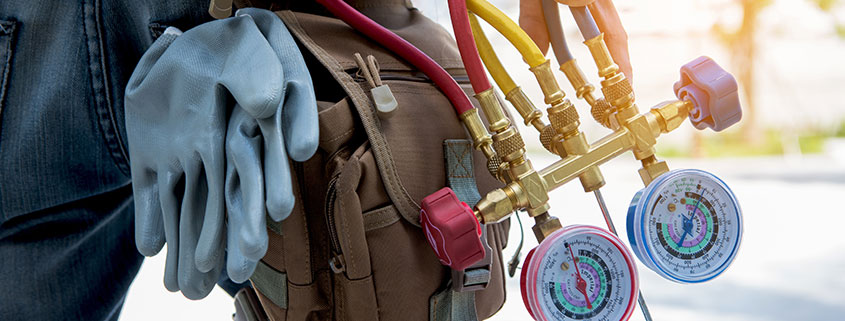Advice from Technicians on heat pump installation ooltewah tn
Advice from Technicians on heat pump installation ooltewah tn
Blog Article
How a Warm Pump and Heater Job With Each Other to Enhance Your Home's Home heating Performance
Comprehending how a warm pump and heating system collaborate is necessary for property owners seeking efficient heating remedies. Each system has its toughness, offering a balanced technique to home convenience. The heatpump masters moderate temperature levels, while the heater provides fast warmth during severe cold. This synergy not just reduces energy prices yet likewise improves the lifespan of both home appliances. What elements influence this collaboration, and how can property owners maximize their benefits?
Recognizing Warmth Pumps: Just How They Function
Although lots of people may be not familiar with their internal functions, heatpump play a necessary duty in contemporary heater. These tools operate by transferring warm from one area to an additional, utilizing the principles of thermodynamics. In cooler months, a warm pump essences warm from the outdoors air, ground, or water, and transfers it indoors to warm the living area. On the other hand, throughout warmer months, it can reverse the process, acting as an ac unit by removing warm from inside to the outside.Heat pumps include an evaporator, development, compressor, and condenser valve. The refrigerant within the system takes in warm as it vaporizes at reduced temperatures and pressures. The compressor after that enhances the pressure and temperature level of the cooling agent, allowing it to release heat as it condenses. This efficient process can greatly minimize power usage contrasted to typical home heating approaches, making heatpump a sustainable option for climate control in homes.
The Function of Heaters in Home Home Heating
Heating systems play an essential role in home heating by providing a trustworthy resource of warmth during the cooler months. They run by producing warm via burning or electrical resistance, distributing it throughout the home through air ducts or glowing systems. The performance of a heating system is often determined by its Annual Fuel Application Effectiveness (AFUE) rating, which indicates exactly how successfully the unit transforms fuel into heat.Furnaces can utilize numerous power sources, consisting of gas, gas, electricity, or oil, enabling home owners to pick one of the most appropriate alternative for their needs. Unlike heatpump, which may battle in severe cool, furnaces keep constant efficiency, ensuring that indoor temperature levels stay comfortable regardless of outside problems. Furthermore, contemporary furnaces usually come outfitted with innovative innovation, such as variable-speed blowers and smart thermostats, enhancing their effectiveness and responsiveness. This versatility makes heating systems a crucial element in all-encompassing home heating techniques.

Benefits of Using Both Systems Together
Incorporating the staminas of both heating systems and heatpump can lead to a much more reliable and reliable home heating solution. Making use of both systems enables property owners to make use of the warm pump's energy performance during milder temperature levels while counting on the heater for even more extreme cold conditions. This twin technique can substantially lower power prices, as warm pumps consume much less electrical energy than standard home heating techniques when temperatures are moderate.Additionally, utilizing both systems with each other can improve convenience degrees in the home. Heatpump can supply consistent, also heating, while furnaces can swiftly raise ambient temperature levels when required. The combination of both systems can expand the life expectancy of equipment by minimizing wear and tear on each unit, as they share the workload. Inevitably, house owners can enjoy a well balanced, cost-efficient home heating solution that changes flawlessly to varying climate condition, guaranteeing a warm and welcoming home throughout the cold weather.
How Warmth Pumps and Furnaces Enhance Each Various Other
They produce a corresponding home heating system that takes full advantage of effectiveness and convenience when house owners incorporate warm pumps and furnaces. Heatpump run by moving warm from the outdoors air or ground, making them highly efficient in moderate climates. They excel throughout milder temperature levels, offering affordable heating. Conversely, furnaces produce heat via burning or electrical resistance, delivering solid, prompt warmth during extreme cool conditions.The combination of these two systems permits for dynamic modifications based on temperature level changes. During warmer months or milder winter months days, the heatpump can take the lead, conserving energy and lowering expenses. As temperatures decline, the heater can flawlessly engage, guaranteeing constant heat throughout the home. This harmony not only optimizes energy usage yet additionally improves the life-span of both systems, as each device runs within its suitable performance array. With each other, they produce a well balanced environment that adjusts to varying climate needs.
Optimizing Efficiency: Tips for Homeowners
Property owners can enhance their home heating effectiveness through numerous sensible techniques. Developing a regular upkeep timetable, incorporating clever thermostat modern technology, and carrying out efficient insulation and securing options are vital steps. These measures not only boost comfort but likewise minimize energy expenses.
Routine Upkeep Schedule
To assure optimal heating effectiveness, developing a normal upkeep timetable is necessary for any type of home. House owners ought to focus on regular evaluations of both warmth pumps and heating systems to determine peak performance. This includes changing air filters each to three months, as clogged filters can greatly decrease performance. Furthermore, scheduling expert maintenance a minimum of yearly allows service technicians to determine and deal with potential concerns before they escalate. Homeowners should also clean up the warm pump's exterior unit to avoid debris buildup that can impede air movement. By adhering to a regular upkeep timetable, property owners not only enhance their heater' performance yet likewise prolong their life-span, causing better convenience and reduced energy prices throughout the colder months.
Smart Thermostat Integration
Incorporating a wise thermostat right into a home heating system can significantly boost energy performance, specifically as it permits for accurate control over temperature level settings. These tools can discover the homeowner's schedule and preferences, automatically adjusting the temperature level to maximize convenience while reducing power use. As an example, they can lower home heating throughout times when the home is unoccupied, lowering unneeded consumption. Several clever thermostats additionally offer top article real-time power use data, allowing home owners to make educated decisions concerning their home heating practices. Furthermore, remote gain access to via smart device apps allows individuals to adjust settings from anywhere, guaranteeing the home is cozy upon return. In general, smart thermostat combination not only boosts comfort yet considerably contributes to energy savings and effectiveness.
Insulation and Securing Solutions
Smart thermostats play a crucial role in power performance, but their performance can be considerably enhanced by proper insulation and sealing services. Home owners must prioritize protecting floors, attics, and walls to minimize warm loss. High-grade insulation products, such as spray foam or fiberglass, can substantially enhance thermal resistance. Additionally, securing spaces around doors, air ducts, and windows prevents cold air seepage and heat retreat. Weatherstripping and caulking are effective approaches for addressing these leaks - ductless mini splits. Routine assessments for air leaks, along with the usage of blower door examinations, can assist identify problem locations. By investing in insulation and securing, homeowners can optimize the performance of their furnace, inevitably resulting in lowered energy usage and lower energy expenses
Common Misconceptions Concerning Heat Pumps and Furnaces
What mistaken beliefs border heatpump and heaters? Numerous individuals mistakenly think that heatpump are ineffective in colder environments. Actually, modern warmth pumps are developed to run efficiently even in reduced temperatures, giving trustworthy home heating throughout winter months. One more typical myth is that heating systems are always much more efficient than heatpump. Nevertheless, this depends on go right here the particular power sources and effectiveness rankings of the units in question. Some might likewise think that using both systems at the same time is unneeded, yet as a matter of fact, this mix can enhance home heating performance, particularly throughout extreme weather. Additionally, people usually think that heat pumps require constant upkeep, when in reality, they have comparable maintenance needs to standard furnace. By debunking these misconceptions, house owners can make even more informed decisions concerning their home heating choices, eventually resulting in enhanced convenience and energy performance in their homes.
Upkeep Considerations for Combined Equipments

Regularly Asked Questions
Can Warmth Pumps Work Efficiently in Exceptionally Cold Climates?
Warmth pumps can struggle in extremely cool climates due to decreased efficiency and warm removal constraints. However, improvements in modern technology have brought about designs designed for far better efficiency in such problems, improving their practicality in rough settings.
The Length Of Time Do Warm Pumps and Furnaces Usually Last?
Heat pumps usually last 15 to 20 years, while heaters have a life expectancy of 15 to three decades. Normal maintenance can prolong their longevity, ensuring effective operation and decreasing the demand for premature replacements.

What Is the Average Expense of Installing Both Solutions?
The typical expense of mounting both a heatpump and a heating system generally ranges in between $5,000 to $10,000 - furnace replacement. Aspects influencing this expense consist of system dimension, installation intricacy, and local labor rates
Exist Tax Rewards for Using Energy-Efficient Home Heating Systems?
Several house owners ask about tax obligation incentives for energy-efficient furnace. Numerous federal and state programs frequently supply debts or rebates, urging the adoption of sustainable innovations to lower energy intake and advertise environmental obligation.
Just how Do I Choose the Right Size Heatpump and Furnace?
Selecting the right size heat pump and heating system entails calculating the home's square video footage, taking into consideration insulation top quality, and examining neighborhood environment. Consulting a professional can guarantee ideal system performance and energy efficiency based upon particular demands. heat pump installation ooltewah tn. Understanding just how a warm pump and heating system work together is crucial for property owners seeking effective heating solutions. In cooler months, a heat pump removes warmth from the outdoors air, ground, or water, and transfers it inside your home to warm up the living room. When home owners incorporate warm pumps and furnaces, they produce a complementary heating system that makes the most of effectiveness and convenience. Heat pumps operate by moving warmth from the outside air or ground, making them very efficient in modest climates. Heat pumps can struggle in incredibly cool environments due to lowered effectiveness and warmth extraction limitations
Report this page